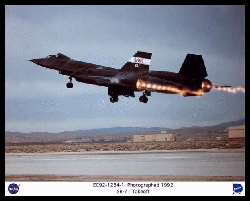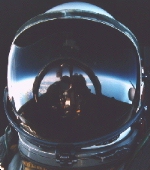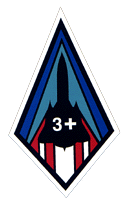SR-71 History


 |
 |
I would like to especially thank the United States Air Force for creating this page and letting me use it!
The SR71 was in active Air Force use between 1997 and 1999. According to the Air Force Website, two SR71A's and one SR71B entered active service in 1995. In 1997 those three SR71's entered active mission status as part of the 9th Reconnaissance Wing at Edwards Air Force Base. Unfortunately, the SR71 was, once again retired in 1999.
Just a quick note:
The SR-71, the world's most advanced strategic reconnaissance aircraft, was delivered to the Strategic Air Command in January 1966.
The SR-71 flew at more than three times the speed of sound at altitudes in excess of 80,000 feet (approximately 15 miles high). Three times the speed of sound (Mach 3) is more than 2,000 miles per hour or about 3,100 feet per second. By comparison, the muzzle velocity of a .30-06 rifle bullet is only 3,000 feet per second. The SR-71 was operated by SAC's 9th Strategic Reconnaissance Wing at Beale Air Force Base, CA.
The SR-71 carried a wide variety of advanced observation equipment and could survey more than 100,000 square miles of the earth's surface in one hour from altitudes above 80,000 feet. The SR-71 out-performed all other reconnaissance aircraft. When President Lyndon B. Johnson announced the SR-71's existence on July 24, 1964, he stated, "The system will be used during periods of military hostilities and in other situations in which U.S. military forces may be confronting foreign military forces."
In September 1974, an SR-71 sped from New York to London and from London to Los Angeles to establish two world speed records. The first new time was on Sept. 1, when Maj. James V. Sullivan, pilot, and Maj. Noel F. Widdifield, reconnaissance systems operator, flew the aircraft 3,461 miles from New York to London in less than 1 hour and 55 minutes. The ground speed, which averaged 1,807 mph, cut nearly three hours off the previous time record set by a British F-4K fighter in 1969. For seven days following the speed run, the SR-71 was on display at the Farnborough International Air Show. This marked the first public showing of the aircraft. On Sept. 8, the SR-71 was flown to Royal Air Force Station Mildenhall to prepare for its return home and another speed record attempt.
On Sept. 13, 1971, Capt. Harold B. Adams, pilot, with Maj. Williams C. Machorek, reconnaissance systems operator, flew the SR-71 across seven time zones from London to Los Angeles in a race with the sun. The 3-hour, 47-minute flight established a record over the 5,431 mile route. An added aerial refueling over the longer distance produced a slower ground speed of 1,436 mph, but the aircraft arrived (by California time) almost four hours before its London-time departure.
In July 1976, over the western part of the United States, the SR-71 set several new absolute and world class records. The first record-setting flight came early in the morning of July 27, when Maj. Adolphus H. Bledsoe Jr., aircraft commander, and Maj. John T. Fuller, reconnaissance systems operator, flew 2,029 mph over a closed circuit course. Flying 2,194 mph the next day, a second SR-71 surpassed two records. Capt. Eldon W. Joesz, aircraft commander, and Maj. George T. Morgan, reconnaissance systems operator, set world absolute and class speed records over a 15 to 25 kilometer straight course. That same day, Capt. Robert C. Helt, aircraft commander, and Maj. Larry A. Elliott, reconnaissance systems operator, flew to 85,069 feet to set records for sustained horizontal flight.
The record flights not only provided valuable training experience, but also focused attention on American technology and strategic deterrent power. For their record-setting flights, the pilots received the De La Vaulx medal given by Federal Aeronautique Internationale. The medal is awarded to individuals for establishing absolute world records for highest performance without regard to size of aircraft or power plant.
The SR-71 is powered by two Pratt & Whitney J-58 turbo jet engines. Each engine is housed in a large nacelle, mounted away from the pencil-shaped fuselage on either side of the aircraft's delta wing. When preparing for a flight, crew members report to the wing's unique physiological support division for a preflight physical, high protein meal and several briefings on weather and special mission characteristics. Once this was completed, they were helped into their special flight gear by division technicians who would stay with them until they were aboard the SR-71 and plugged into its systems.
Super sonic missions are continually flown over parts of the United States to test the aircraft and its systems and to maintain crew proficiency. Missions include air refueling over corridors approved by the Federal Aviation Administration. Care is taken in choosing these paths to avoid highly populated areas where possible.
On March 6, 1990, the SR-71 set a cross-country record of 68 minutes, 17 seconds from Oxnard, CA. to Salisbury, super sonic three additional speed records en route, the aircraft covered the 2,404.05 mile journey at an average speed of 2,110 mph. This Blackbird, tail number 972, was being delivered to the Smithsonian Institution's National Air and Space Museum in Washington D.C. for permanent display.
On Oct. 15, 1964, the Department of Defense announced that Beale would be the home of the new, super sonic reconnaissance aircraft, the SR-71 "Blackbird." The 4200th Strategic Reconnaissance Wing activated on Jan. 1, 1965. The new wing received its first aircraft, a T-38 Talon, on July 8, 1965. The first SR-71 did not arrive until Jan. 7, 1966. On June 25, the 9th Strategic Reconnaissance Wing, that began as the 9th Observation Group in 1922, and its 1st Strategic Reconnaissance Squadron activated as the 1st Aero Squadron in 1913, replaced the 4200th. The first U-2 arrived from Davis Monthan on July 12, 1976. In Jan. 26, 1990, budget restrictions forced the retirement of the SR-71. In 1994, Congress appropriated funds and directed the Air Force to recommission a small fleet of SR-71's -- two A models and one B model -- to be operational by Sept. 1995. The aircraft are assigned to the 9th Reconnaissance Wing's Detachment 2 at Edwards Air Force Base, California.
Ten other Blackbirds are on permanent display
at air bases and museums around the country. These aircraft can
be seen at: the Air Force Museum, Wright-Patterson Air Force Base,
Ohio; Offutt Air Force Base, Neb.; March Field Museum, March Air
Force Base, CA.; Beale Air Force Base, CA.; United States
Air Force Plant 42, Palmdale, CA.; Edwards Air Force Base,
CA.; Robins Air Force Base, Ga.; Eglin Air Force Base, Fla.;and
Lackland Air Force Base, Texas.
